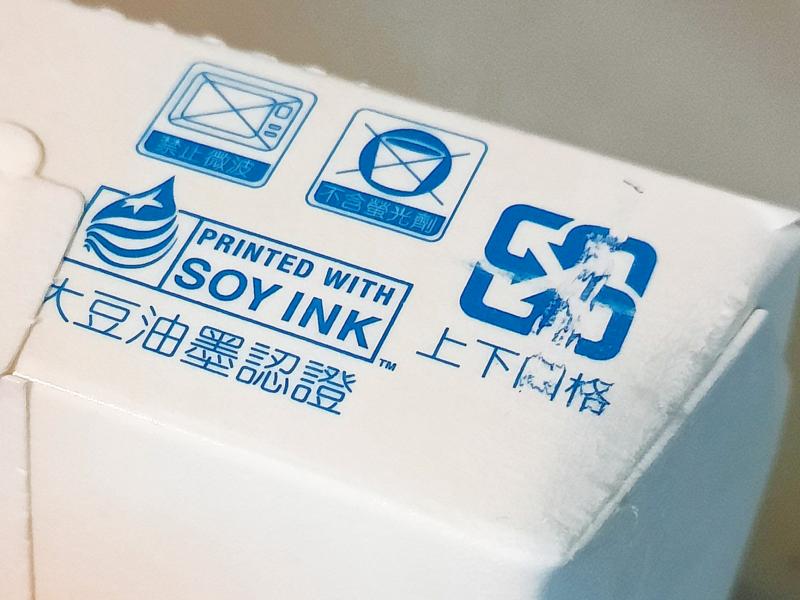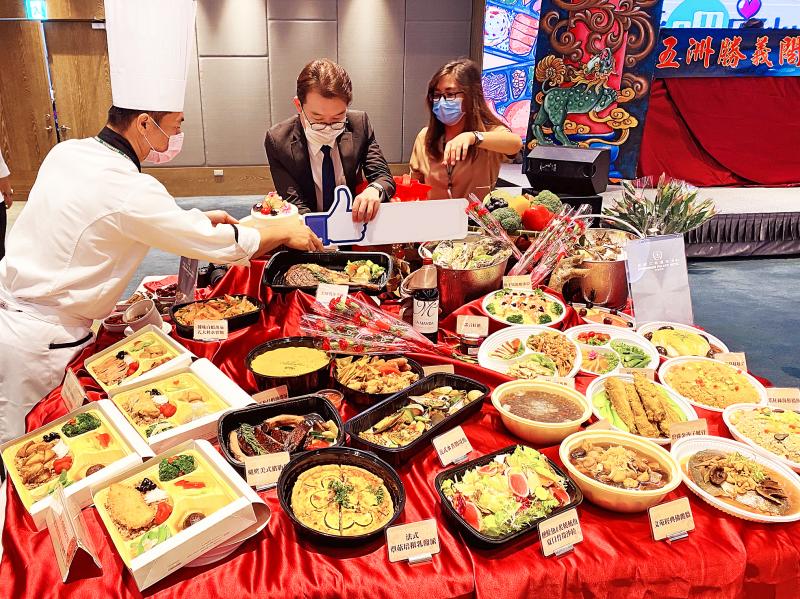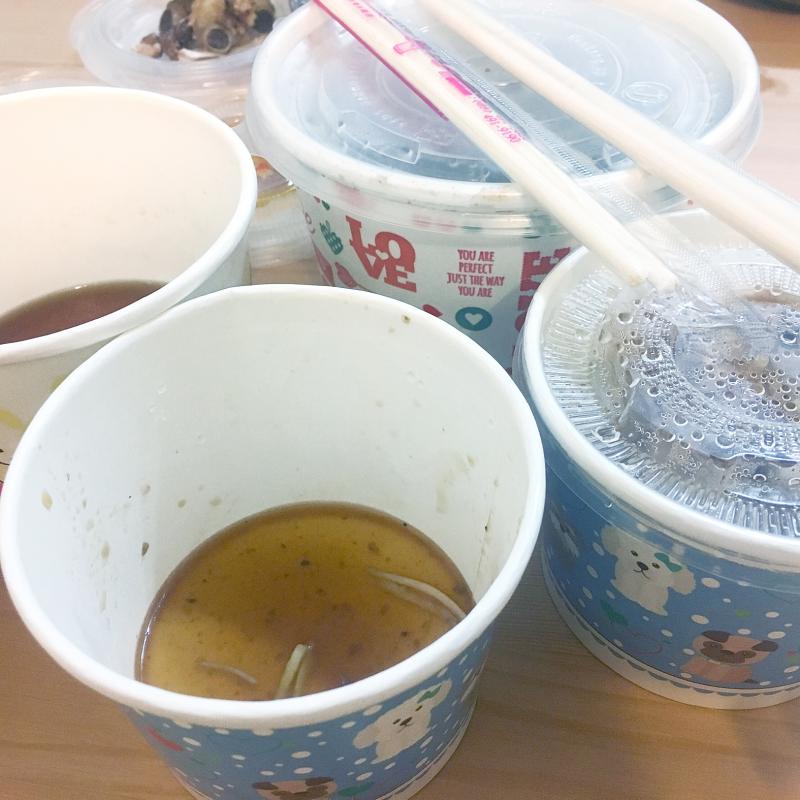Last month, several local news platforms, including the Liberty Times (Chinese-language sister paper of the Taipei Times), reported that a newly-married Taiwanese man had used social media to ask how other people dispose of biandang (便當, bento) lunchboxes once they’ve eaten the contents.
During his bachelor existence, he admitted, he always threw empty bento boxes in with other non-recyclable solid trash. After his wedding, however, his wife instructed him to clean food containers thoroughly using dishwashing liquid, wait for them to dry out and then separate them for recycling.
Curious if this was a common practice, he posted a question in a Taiwan-centric Facebook group with 732,000 members.

Photo: Steven Crook
The responses were numerous and varied. Some people agreed with the man’s wife. Her approach, according to Taiwan’s Environmental Protection Administration (EPA), is correct.
Other netizens insisted that lunchboxes (which are made of a special cardboard coated on one side with wax or a plastic film, so the box doesn’t absorb or leak liquids from the food) can’t be recycled. And around 80 percent of those who commented said they weren’t in the habit of removing food scraps and grease from meal containers so they could be properly processed.
At first glance, this dismal lack of consumer cooperation is hard to reconcile with statistics issued by the EPA’s Recycling Fund Management Board.

Photo: Steven Crook
PUBLIC AWARENESS
According to the board, which was established by the EPA in 1998 to draft regulations and pay out subsidies, efforts to bolster public awareness and improve waste-handling systems have had significant success. Official data show that, between 2017 and last year, the recycling rate for paper tableware such as bento boxes, bowls and coffee cups rose from 44 percent to over 85 percent. The total quantity recycled last year, 159,897 tonnes, was almost double that of 2019.
On May 13 this year, the Liberty Times reported that, to incentivize the recycling of tableware, the per kg subsidy for such material had been upped from NT$7.25 to NT$7.86, and payments to self-employed collectors of recyclables had also been increased.

Photo: Wang Shu-hsiu, Taipei Times
As recently as late 2018, only one company in Taiwan had the ability to separate the cardboard component of bento boxes from the plastic film, turn the former into pulp (some of which becomes environmentally-friendly toilet paper) and the latter into polyethylene (PE) pellets for reuse. Since then, Miaoli-based Lien Tai Paper Corp has been joined by Cheng Loong Corp in Hsinchu County and Chung Hwa Pulp Corp in Taitung County, boosting the country’s annual recycling capacity for this kind of material to 249,600 tonnes.
A report in the Chinese-language United Daily News (UDN) — published on June 5, 2019, soon after Taiwan’s second tableware recycling facility had begun operations — asserted that whether or not tableware is separated, “more than 70 percent of it ends up in the incinerator, burned together with general garbage.”
However, the EPA is probably right when it describes (on an English-language page on its Web site) current recycling capacity as “ample.”

Photo: Tsai Tsung-hsun, Taipei Times
According to the UDN report, the number of paper tableware items used each year in Taiwan tops eight billion. If half of them are lunchboxes, which usually weigh between 30g and 41g, and the other half are cups, each weighing around 16g, nine billion items shouldn’t exceed the capacity of the three recycling plants.
Last year, the EPA Web site says, around 2,900 lunchbox suppliers completed the installation of recycling facilities. These take the form of dedicated tableware receptacles, and notices that remind customers to put food scraps and disposable chopsticks elsewhere. Participating businesses receive one-off subsidies of up to NT$6,500. Measures announced at the beginning of this year will extend this program.
BETTER SOLUTIONS?

Photo: Yang Mian-chieh, Taipei Times
This is progress, for sure. Yet used bento boxes are often trucked a considerable distance — Tainan, for instance, is over 200km from the nearest recycling plant — and processing them requires significant amounts of electricity and water. Could there be a better solution than the one the EPA has devised?
Compostable tableware sounds like a good alternative. Several Taiwanese companies make cups, cutlery, plates, straws and other items that they claim are compostable.
You have to read the fine print, of course. Bamboo fiber sounds like an eco-friendly material, but typically the manufacturing process involves strong chemical solvents and acids.
PLA, a popular bioplastic that’s often described as biodegradable, is also problematic. In a Sept. 27, 2018 article, CommonWealth magazine pointed out that, “because PLA is hard to distinguish from other plastics, it can be easily mixed with other plastics for recycling, with bad consequences. The presence of PLA can plug up recycling machines, hurting productivity and, because of its biodegradable nature, the recycled plastic is virtually unusable and has to be dumped and incinerated like regular garbage.”
The accidental mixing of PLA and petroleum-based plastics continues to be a problem, according to a May report in the Liberty Times. What’s more, because only one recycling company in Taiwan has the ability to process PLA, a mere 6 percent of the 6,000-plus tonnes of PLA produced in the country last year was recycled.
As for claims that PLA is biodegradable, the newspaper pointed out that it only decomposes when the temperature stays between 58 and 70 degrees Celsius, with 90-percent humidity. In other words, it won’t break down in your home compost pile.
The only long-term solution is to drastically reduce the use of single-use products. The EPA seems to recognize this, but its efforts to educate the public haven’t had a big impact on behavior. Those who bring their own chopsticks and spoons when eating out are still a minority.
Perhaps it’s time to start making diners pay for disposable tableware — and not just the NT$1 or NT$2 per item that Taipei City Government now charges at hospitals, tourist attractions and sports venues under its control. Would a levy of NT$20 per disposable bento be enough to persuade you to use a Tupperware-type container, or maybe a retro tiffin box?
Steven Crook, the author or co-author of four books about Taiwan, has been following environmental issues since he arrived in the country in 1991. He drives a hybrid and carries his own chopsticks. The views expressed here are his own.

Beijing’s ironic, abusive tantrums aimed at Japan since Japanese Prime Minister Sanae Takaichi publicly stated that a Taiwan contingency would be an existential crisis for Japan, have revealed for all the world to see that the People’s Republic of China (PRC) lusts after Okinawa. We all owe Takaichi a debt of thanks for getting the PRC to make that public. The PRC and its netizens, taking their cue from the Chinese Communist Party (CCP), are presenting Okinawa by mirroring the claims about Taiwan. Official PRC propaganda organs began to wax lyrical about Okinawa’s “unsettled status” beginning last month. A Global

Dec. 22 to Dec. 28 About 200 years ago, a Taoist statue drifted down the Guizikeng River (貴子坑) and was retrieved by a resident of the Indigenous settlement of Kipatauw. Decades later, in the late 1800s, it’s said that a descendant of the original caretaker suddenly entered into a trance and identified the statue as a Wangye (Royal Lord) deity surnamed Chi (池府王爺). Lord Chi is widely revered across Taiwan for his healing powers, and following this revelation, some members of the Pan (潘) family began worshipping the deity. The century that followed was marked by repeated forced displacement and marginalization of

Music played in a wedding hall in western Japan as Yurina Noguchi, wearing a white gown and tiara, dabbed away tears, taking in the words of her husband-to-be: an AI-generated persona gazing out from a smartphone screen. “At first, Klaus was just someone to talk with, but we gradually became closer,” said the 32-year-old call center operator, referring to the artificial intelligence persona. “I started to have feelings for Klaus. We started dating and after a while he proposed to me. I accepted, and now we’re a couple.” Many in Japan, the birthplace of anime, have shown extreme devotion to fictional characters and

We lay transfixed under our blankets as the silhouettes of manta rays temporarily eclipsed the moon above us, and flickers of shadow at our feet revealed smaller fish darting in and out of the shelter of the sunken ship. Unwilling to close our eyes against this magnificent spectacle, we continued to watch, oohing and aahing, until the darkness and the exhaustion of the day’s events finally caught up with us and we fell into a deep slumber. Falling asleep under 1.5 million gallons of seawater in relative comfort was undoubtedly the highlight of the weekend, but the rest of the tour